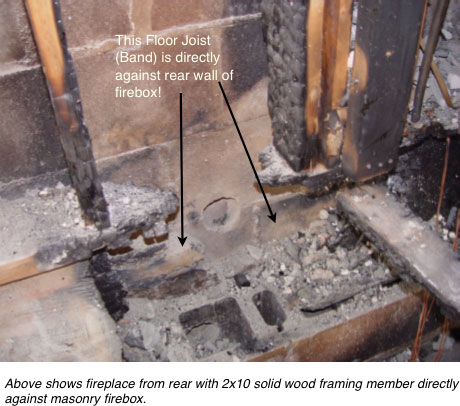Note: Some opinions and facts...in other words, a discussion of various issues with masonry fireplaces and nearby framing - are presented below.
It is well known in the trade that most existing masonry fireplaces ARE NOT BUILT TO CURRENT CODE. This is fairly obvious since the code has changed in recent years and most were built prior. However, many of them do not even meet a "common sense" code - meaning that which would keep nearby wood framing and other materials from combustion IF the fireplace was used very heavily. Luckily, as you will read below, most are not!
So, let's talk about the potential dangers from the fireplace opening (FIREBOX) AND from the chimney.
The Chimney
Most relatively modern masonry chimneys that are relined (with stainless steel)- with or without insulation - are probably rendered relatively safe in terms of radiant heat from the smoke chamber up. The reason is simple - most liners are round in shape and radiation from a round tube to any particular point is vastly less than that of large flat surfaces. Moreover, the liner provides an air space around it - and even if it touches the masonry in some areas, this "bearing" surface is very small.
Most FIREBOXES are also made safer when a stove or insert is installed unless the offending wood is very near the insert or stove....like a few inches above it. This can also depend on the stove - certain models like the non-cat VC units put vast amounts of heat upwards. These may benefit from a heat shield which extends underneath the fireplace lintel and out front to protect any wood mantels or trim (see the stove manual).
EXPOSED WOOD - The codes seem a bit more lenient on exposed wood trim for good reason - you can see it, you can feel it, and it is cooled by the passage of room air over it. This is often not true with wood buried deep in the masonry firebox area or hearth (bottom).
Why, then, are open fireplaces not starting LOTS of house fires
Now, here is somewhat of common sense answer - but one that a lot of
People might not want to hear. Most are fine as long as people dont use them! And, most people dont use them....I mean very heavily. BUT, if folks were to burn these open fireplaces (with wood nearby) 24/7 (for instance in a power failure), then we would have a vast increases in house fires almost right away.
I have enclosed a PDF here detailing an inspection I did on a million dollar house which experienced such a fire - the pictures and text will give you some idea of the dangers involved.
This is the PDF
http://hearth.com/images/uploads/housefire1.pdf
Please note that the reason this house fire occurred is exactly as stated above - a power failure caused the owners to run it 24/7 for a day or two....and it ignited after about 24 hours of use (much longer than the UL test).
Another interesting fact as regards masonry fireplaces is that EVEN ONE BUILT TO CURRENT STANDARDS (which most are not) WOULD FAIL THE CURRENT UL TESTING USED FOR STOVES AND METAL (PRE-FAB ZC) FIREPLACES.
For proof of this, we need only look at the actual test done by a major test lab and paid for by the Brick Industry Association. A link to the basics on this is at:
http://www.rumford.com/woodburningregulation/clearancetest.html
The summary is this:
The left side (attached to the 8" thick side) combustible panel exceeded the limitation of 90 degrees F above ambient at 9 hours and 30 minutes into the test and rose to 10 degrees above the limit by the end of the test.
The right side (attached to the 12" thick side) combustible panel did not exceed the limitations, however, did exceed the limitation by as much as 18 degrees 3 hours and 20 minutes after the test had ended.
The exact details for Masonry Fireplace construction are beyond the scope of this entry, but let me point you to a few pages which have much of the relevant info:
http://www.rumford.com/code/IRC06.html
http://www.rumford.com/code/code.html
Applying these lessons to Stove and Insert Installations into existing Masonry Fireplaces
As mentioned above, a relined chimney often will mitigate most of the potential problems from the fireplace
Damper upwards. But installers should still keep many potential danger areas in mind. A "common sense" view which takes into account the particular stove or insert to be installed is very important. For instance, a traditional fireplace insert which installs well back into the fireplace and has a second wall of steel 100% around it will often make ALL the masonry firebox temperatures much lower. So this type of traditional insert may provide less of a danger than certain others. Of most note to installers should be:
1. Inserts or Hearth Stoves which extend out of the fireplace
Since the fireplace was designed to have a fire way back inside, an extended unit can put heat radiation into areas which were not designed for those temps. This includes the hearth extension, the hearth itself (especially if the insert does not have a large air space built-in below the actual fire), and the surrounding masonry and mantel. Your owners manual should address these points, but a thorough inspection before installation will help also. Look for vertical cracks between the front fireplace facing and the firebrick inside - also look upwards behind the lintel - hopefully you cannot see a wood framing member close by!.
2. Units with single wall sides or tops or units with no air space below the fire.
These units can create extreme radiation on nearby surfaces. Once again, the owners manual in addition to common sense and a trained eye are your best allies. Keep in mind that you may use your stove 24/7 so that the heat radiation and spread could far exceed that of a short fire in the fireplace.


